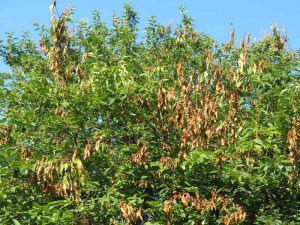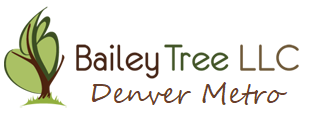Fire Blight Treatment in Denver
 Why am I on fire?
Why am I on fire?
Fireblight is a bacterium that attacks a variety of species in the Rose family.
Crabapples, Apples, Hawthorns, Pears, and Pyracanthas are among the most prevalent species attacked. The bacterial infection is spread in the spring via pollinators during the pollination process on the flowers.
Our spring weather greatly fluctuates along the Front Range. Springs when we are rather warm, with increased humidity during the blooming period are ripe conditions for Fireblight activity.
The Bacterial infections vary from year to year, based upon our weather conditions.
Sometimes new symptoms can be seen occurring well into early Jul It really depends upon our weather for the time of year. Years when we experience a spring freeze during peak bloom season, it can often greatly reduce the risk of infection.
The bacterial infection can become so severe it can make its way into some of older woody tissue. Over time the infection will result in branch dieback, and eventually to larger lateral wood dieback and decay.
Best fire blight management practices include:
1. Planting of resistant varieties
2. Diversification of plantings
3. Only Prune in Winter months
4. Slowing of growth of succulent tissue-do not fertilize known infected trees or shrubs in spring.
5. Cultural practices to include:
- Remove the infected areas during the winter (dormant months) to reduce the spread of the infection.
- Treatment options include:
- A canopy spray.
- A trunk injection
- Basal bark spray
6. All applicable preventive treatments are completed in the spring.
7. Symptoms include:
- The tip of the branch curling into a Shepard’s crook, with the tip turning a fiery-orange color.
- Discoloration of the bark
- Sometimes pimpling
Please call Bailey Tree to request your area arborist to visit the site and meet your tree to provide a plan for management of this bacterial infection.
How does fire blight spread?
It is commonly spread by bees when the bark is damaged during the growing season.
Does fire blight occur naturally?
Yes – fire blight occurs naturally in Denver and in fruit trees across the world.
Is fire blight dangerous to animals?
No – fire blight is not known to cause issues or illnesses for animals.
Does fire blight go away on its own?
Weather and other environmental factors can have a positive effect on limiting Fire Blight. But if a tree has it, it will generally last the whole growing season and possibly into the next growing season especially if the infected parts are not cut out or if the tree is not treated.
How can I prevent fire blight?
Don’t make wounds on the tree during the growing season, (Spring – Fall)
What’s the cost of fire blight treatment?
Around $10 per diameter inch, of the trunk of the tree, for the anti-bacterial treatment, and $10 per diameter inch for a growth regulator product.
